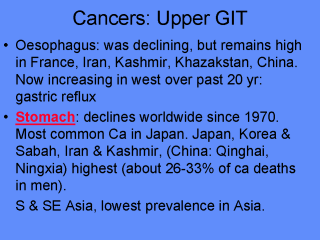| front |1 |2 |3 |4 |5 |6 |7 |8 |9 |10 |11 |12 |13 |14 |15 |16 |17 |18 |19 |20 |21 |review |
 |
We will first
look at common cancers of the upper, mid and lower GI tract. Cancer of the oesophagus is a common cancer which has been showing variable patterns of change worldwide. There is a high prevalence of oesophageal cancers in what is called the "crescent", a geographic range which stretches through Iran, Kashmir, Khazakstan and into China. Rates are also high in parts of France. While rates have been low for some years in the UK, they have shown an increase over the past decade. Some researchers have attributed this to increasing use of H2 receptor antagonists for stomach ulcers. Others have linked it to the prevalence of Helicobacter Pylori, though some evidence suggests childhood H.P. infection may lead to distal gastric adenocarcinomas, but be protective against some forms of cancer of the proximal stomach and oesphageal juncture, (Williams & Pounder, Am-J-Gastroenterol. 1999). Cancers of the stomach have been declining in incidence worldwide over the past 30 years, with particularly notable declines in Japan and Korea, where stomach cancer remains the most prevalent cancer among men. In China, rates are highest in Qinghai and Ningxia, accounting for between one quarter to one third of cancer diseases among men. South and south-east Asia have the lowest prevalence of gastric cancers within Asia |
| front |1 |2 |3 |4 |5 |6 |7 |8 |9 |10 |11 |12 |13 |14 |15 |16 |17 |18 |19 |20 |21 |review |